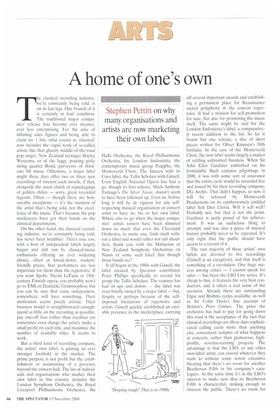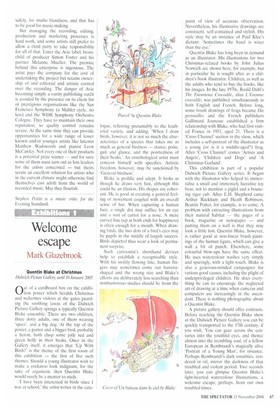A home of one's own
Stephen Pettitt on why many organisations and artists are now marketing their own labels
The classical recording industry. were constantly being told, is on its last legs. One branch of it is certainly in frail condition. The traditional major companies' release lists become ever meaner, ever less enterprising. For the sake of inflating sales figures and being able to claim no. 1 hits, what counts as 'classical' now includes the vapid work of so-called artists like that ghastly middle-of-the-road pop singer, New Zealand teenager Hayley Westenra, or of the leggy, pouting girlie string quartet Bond, purveyors of thirdrate lift music. Otherwise, a major label might these days offer two or three new recordings of interest each month, if that, alongside the usual clutch of repackagings of golden oldies — sorry, great recorded legends. Often — though there are honourable exceptions — it's the stardom of the artist that's being sold, not the excellence of the music. That's because the pop marketeers have got their hands on the classical departments.
On the other hand, the classical recording industry, we're constantly being told, has never been healthier. That's true too, with a host of independent labels largely begun and still run by classical-music enthusiasts offering an ever widening choice, often at knock-down, studentfriendly prices. Star performers arc less important for them than the repertoire. If you want Spohr, Nicola LeFanu or 19thcentury Finnish opera, you probably won't go to EMI or Deutsche Grammophon, but you can be sure that some independent, somewhere, will have something. Their motivation seems purely artistic. Their business model is straightforward enough: spend as little on the recording as possible, pay one-off fees rather than royalties (or sometimes even charge the artist), make a small profit on each title, and maximise the number of available titles. It seems to work.
But a third kind of recording company, the artists' own label, is gaining an ever stronger foothold in the market. The prime purpose is not profit but the establishment or maintaining of a presence beyond the concert hall. The list of individuals and organisations who market their own label in this country includes the London Symphony Orchestra, the Royal Liverpool Philharmonic Orchestra, the Halle Orchestra, the Royal Philharmonic Orchestra, the London •Sinfonietta, the contemporary music group Psappha, the Monteverdi Choir, The Sixteen with its Coro label, the Tallis Scholars with Gimell. Even English National Opera has had a go, though its first release, Mark-Anthony Turnage's The Silver Tassie, doesn't seem to have been followed up. Even so, before long it will be de rigueur for any selfrespecting musical organisation or concert artist to have its, his or her own label. Where else to go when the major companies' artists rosters have been slimmed down so much that even the Cleveland Orchestra, to name one, finds itself without a label and would rather not rub shoulders, thank you, with the Malaysian or New Zealand Symphony Orchestras on Naxos or some such label, fine though those bands are?
It all began in the 1980s with Gimell, the label created by Spectator contributor Peter Phillips specifically to record his group the Tallis Scholars. The venture has had its ups and downs — the label was even briefly owned by a major label — but, despite or perhaps because of the selfimposed limitations of repertoire and artists, Gimell quickly established an enviable presence in the marketplace, carrying off several important awards and establishing a permanent place for Renaissance sacred polyphony in the concert repertoire. It had a mission for self-promotion for sure, but also for promoting the music itself. The same might be said for the London Sinfonietta's label, a comparatively recent addition to the list. So far it boasts but one release, a disc of short pieces written for Oliver Knussen's 50th birthday. In the case of the Monteverdi Choir, the new label seems largely a matter of settling unfinished business. When Sir John Eliot Gardiner embarked on his formidable Bach cantatas pilgrimage in 2000, it was with some sort of assurance that the entire cycle would be recorded live and issued by his then recording company, DG Archiv. That didn't happen, so now it will be released by Monteverdi Productions on its cumbersomely entitled label Soli Dec Gloria. Will it sell well? Probably not, but that is not the point. Gardiner is justly proud of his achievement. It was an audacious thing to attempt, and was also a piece of musical history probably never to be repeated. It's only right that the public should have access to a record of it.
The vast majority of these artists' own labels are devoted to live recordings (Gimell is an exception), and that itself is something of a revolution. One huge success among critics — I cannot speak for sales — has been the LSO Live series. It's cheap to buy, it features the very best conductors, and it offers a real sense of the occasion. Already there are outstanding Elgar and Brahms cycles available, as well as Sir Colin Davis's fine account of Britten's Peter Grimes. The price the orchestra has had to pay for going down this road is the acceptance of the fact that classical recordings are these days sophisticated calling cards more than anything else, convenient samples of what happens at concerts, rather than glamorous, highprofile, revenue-earning projects. The advantage is that the LSO, or any other own-label artist, can record whatever they want to without some senoir executive bleating that there's no room for another Beethoven Fifth in his company's catalogues. At the same time it's in the LSO's interest to make sure that its Beethoven Fifth is characterful, striking enough to interest the public. There's no room for
safety, for studio blandness, and that has to he good for music-making.
But managing the recording, editing, production and marketing processes is hard work, and some artists still prefer to allow a third party to take responsibility for all of that. Enter the Avie label, brainchild of producer Simon Foster and his partner Melanne Mueller. The premise behind this enterprise is ingenious. The artist pays the company for the cost of undertaking the project but retains ownership of and editorial and artistic control over the recording. The danger of Avie becoming simply a vanity publishing outfit is avoided by the presence on its client list of prestigious organisations like the San Francisco Symphony (a Mahler cycle, no less) and the WDR Symphony Orchestra Cologne. They have to maintain their own reputation, so quality control remains severe. At the same time they can provide opportunities for a wide range of lesser known and/or younger artists like lutenist Matthew Wadsworth and pianist Leon McCawley. Not every one of their products is a potential prize winner — and for sure some of them must turn out as loss leaders for the artists concerned — but theirs seems an excellent solution for artists who in the current climate might otherwise find themselves cast adrift from the world of recorded music. May they flourish.
Stephen Penni is a music critic for the Evening Standard.



























































































 Previous page
Previous page